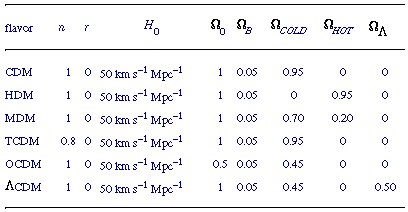


There are exactly 31 different combinations of n, r, cosmological parameters, and dark matter mixes. (2) For this reason, different cosmological models are like flavors of ice cream at Baskin Robbins. There is always a flavor of the month that everyone seems to like. Flavors come in and out of taste / fashion, with some adherents always choosing the same, while others like to sample a wide variety. A menu of the six most popular flavors is given in Table 2.

Obviously, other combinations are possible. A comparison of the
power spectrum in these models to our impressionist version of the
observationally determined power spectrum is shown in
Fig. 7. Obviously CDM has too much power on
small scales.
Hot dark matter is a disaster because it has no power on small
scales. Tilted dark matter does better than CDM. Mixed dark matter
does somewhat better, as does  dark matter (not shown).
Rather than
dark matter (not shown).
Rather than  -by-eye, I quote the
results of one statistical
analysis, including many data sets, in Table 3
[2].
-by-eye, I quote the
results of one statistical
analysis, including many data sets, in Table 3
[2].
My reading of the comparison between data and experiment is that the results of Table 3 should be regarded as a relative measure of the agreement between models and present data. For instance, it is fair to say that MDM is a much better fit than CDM. But one should be very careful before rejecting a model based upon these numbers.
| model |  2 / d.o.f 2 / d.o.f
|
| CDM | 3.8 |
| TCDM | 2.1 |
 CDM CDM
| 1.9 |
| OCDM | 1.8 |
| MDM | 1.2 |
Although one might get the best  2 with a model having 10%
baryons, 30% cold dark matter, 30% hot dark matter with 15% each in
two species of neutrinos, 20% cosmological constant, 10% warm dark
mater, and seasoned with a little tilt, it doesn't mean that is the
way the universe is constructed.
2 with a model having 10%
baryons, 30% cold dark matter, 30% hot dark matter with 15% each in
two species of neutrinos, 20% cosmological constant, 10% warm dark
mater, and seasoned with a little tilt, it doesn't mean that is the
way the universe is constructed.
Clearly, what is needed are better observations: finer-scale observations of CBR fluctuations, as well as larger-scale determinations of the power spectrum from large-scale structure surveys. In the next few years such experiments will be done.
There is now an aggressive campaign to measure CBR anisotropies on fine angular scales. The culmination of this program will be the launch of two satellites - MAP by NASA and Planck by ESA.
Large-scale structure surveys are also progressing. The largest
(three-dimensional) survey to date is the Las Campanas Redshift
Survey, containing the three-dimensional location of over 30,000
galaxies. In the next two years another survey, called 2dF, will be
completed. This survey will have about 100,000 galaxies in its
catalog. Finally, the Sloan Digital Sky Survey will map  steradians of the north galactic cap and find the location of
1,000,000 galaxies, along with 150,000 quasars.
steradians of the north galactic cap and find the location of
1,000,000 galaxies, along with 150,000 quasars.
By the time these experiments/observations are complete we will be in the age of precision cosmology, and we should really be able to compare theory and observation.
The remaining missing piece of the puzzle may be the identity of the dark matter.